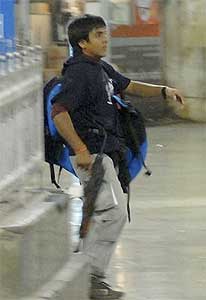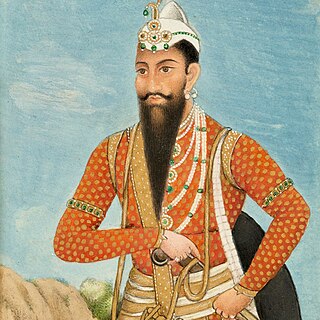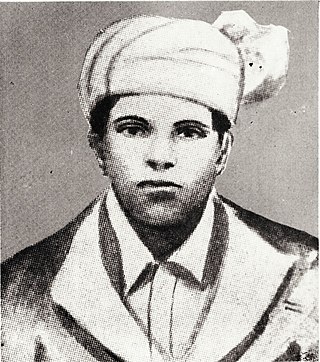
The Koh-i-Noor, also spelled Koh-e-Noor,Kohinoor and Koh-i-Nur, is one of the largest cut diamonds in the world, weighing 105.6 carats (21.12 g). It is part of the Crown Jewels of the United Kingdom. The diamond is currently set in the Crown of Queen Elizabeth The Queen Mother.
Embalming is the art and science of preserving human remains by treating them to forestall decomposition. This is usually done to make the deceased suitable for viewing as part of the funeral ceremony or keep them preserved for medical purposes in an anatomical laboratory. The three goals of embalming are sanitization, presentation, and preservation, with restoration being an important additional factor in some instances. Performed successfully, embalming can help preserve the body for a duration of many years. Embalming has a very long and cross-cultural history, with many cultures giving the embalming processes a greater religious meaning.
Swathi Thirunal Rama Varma was the Maharaja of the Kingdom of Travancore. He is also considered as a brilliant music composer and is credited with over 400 classical compositions in both Carnatic and Hindustani style.
The Treaty of Amritsar, executed by the British East India Company and Raja Gulab Singh of Jammu after the First Anglo-Sikh War, established the princely state of Jammu and Kashmir under the suzerainty of the British Indian Empire.

Body snatching is the illicit removal of corpses from graves, morgues, and other burial sites. Body snatching is distinct from the act of grave robbery as grave robbing does not explicitly involve the removal of the corpse, but rather theft from the burial site itself. The term 'body snatching' most commonly refers to the removal and sale of corpses primarily for the purpose of dissection or anatomy lectures in medical schools. The term was coined primarily in regard to cases in the United Kingdom and United States throughout the 17th, 18th, and 19th centuries. However, there have been cases of body snatching in many countries, with the first recorded case dating back to 1319 in Bologna, Italy.

Maharaja Sir Duleep Singh, GCSI, or Sir Dalip Singh, and later in life nicknamed the "Black Prince of Perthshire", was the last Maharaja of the Sikh Empire. He was Maharaja Ranjit Singh's youngest son, the only child of Maharani Jind Kaur.

A burial vault is a container, formerly made of wood or brick but more often today made of metal or concrete, that encloses a coffin to help prevent a grave from sinking. Wooden coffins decompose, and often the weight of earth on top of the coffin, or the passage of heavy cemetery maintenance equipment over it, can cause the casket to collapse and the soil above it to settle.

After Abraham Lincoln was assassinated on April 14, 1865, a three-week series of events was held to mourn the death and memorialize the life of the 16th president of the United States. Funeral services, a procession, and a lying in state were first held in Washington, D.C., then a funeral train transported Lincoln's remains 1,654 miles (2,662 km) through seven states for burial in Springfield, Illinois. Never exceeding 20 mph, the train made several stops in principal cities and state capitals for processions, orations, and additional lyings in state. Millions of Americans viewed the train along the route and participated in associated ceremonies.

Premature burial, also known as live burial, burial alive, or vivisepulture, means to be buried while still alive.

A burial vault is a structural stone or brick-lined underground tomb or 'burial chamber' for the interment of a single body or multiple bodies underground. The main difference between entombment in a subterranean vault and a traditional in-ground burial is, that the coffin is not placed directly in the earth, but is placed in a burial chamber, specially built for this purpose. A burial vault refers to an underground chamber, in contrast to an above-ground, freestanding mausoleum. These underground burial tombs were originally and are still often vaulted and usually have stone slab entrances. They are often privately owned and used for specific family or other groups, but usually stand beneath a public religious building, such as a church, or in a churchyard or cemetery. A crypt may be used as a burial vault and a freestanding mausoleum may contain a burial vault beneath the ground.
The Treaty of Lahore of 9 March 1846 was a peace-treaty marking the end of the First Anglo-Sikh War. The treaty was concluded, for the British, by the Governor-General Sir Henry Hardinge and two officers of the East India Company and, for the Sikhs, by the seven-year-old Maharaja Duleep Singh and seven members of Hazara, the territory to the south of the river Sutlej and the forts and territory in the Jalandhar Doab between the rivers Sutlej and Beas. In addition, controls were placed on the size of the Lahore army and thirty-six field guns were confiscated. The control of the rivers Sutlej and Beas and part of the Indus passed to the British, with the Provision that this was not to interfere with the passage of passenger boats owned by the Lahore Government. Also, provision was made for the separate sale of all the hilly regions between River Beas and Indus, including Kashmir, by the East India Company at a later date to Gulab Singh, the Raja of Jammu.
Sarabjit Singh Attwal was an Indian national convicted of terrorism and spying by a Pakistani court. He was tried and convicted by the Supreme Court of Pakistan for a series of bomb attacks in Lahore and Faisalabad that killed 14 bystanders in 1990. However, according to India, Sarabjit was a farmer who strayed into Pakistan from his village located on the border, three months after the bombings.

Ishaq Bux was an Indian actor.

Mohammed Ajmal Amir Kasab was a Pakistani terrorist and a member of the Islamic terrorist organization Lashkar-e-Taiba through which he took part in the 2008 Mumbai terrorist attacks in Maharashtra, India. Kasab, alongside fellow Lashkar-e-Taiba recruit Ismail Khan, killed 72 people during the attacks, most of them at the Chhatrapati Shivaji Terminus. Kasab was the only attacker captured alive by police.

Bamba Müller was the wife of Maharaja Duleep Singh, the last Maharaja of Lahore. Brought up by Christian missionaries, her transformation from illegitimate girl, born to a German father and Abyssinian (Ethiopian) mother, living in a Cairo mission to a Maharani living a life of luxury with the "Black Prince of Perthshire" has been compared to the "Cinderella" story.

In the United Kingdom, state funerals are usually reserved for monarchs. The most recent was the state funeral of Queen Elizabeth II on 19 September 2022.

Kharak Singh was the second Maharaja of the Sikh Empire. He was the eldest son of Maharaja Ranjit Singh, founder of the Sikh Empire and his consort, Maharani Datar Kaur. He succeeded his father on 27 June 1839 and reigned until his dethronement and imprisonment on 8 October 1839. He was succeeded by his only son Nau Nihal Singh.
Lieutenant colonel Frederick MackesonCB was an East India Company officer operating in the North West Frontier of British India and one of Henry Lawrence's "Young Men".

Hari Kishan Talwar was an Indian revolutionary from North-West Frontier Province. He is known mainly for his attempt to assassinate the Governor of Punjab, Sir Geoffrey de Montmorency. He was a young disciple of Bhagat Singh. He was hanged on 9 June 1931 in Mianwali Jail.
A burial artist is a person who intentionally endures premature burial by being voluntarily buried for extended periods as a form of human endurance contests, endurance art, escapology, or magic (illusion).













